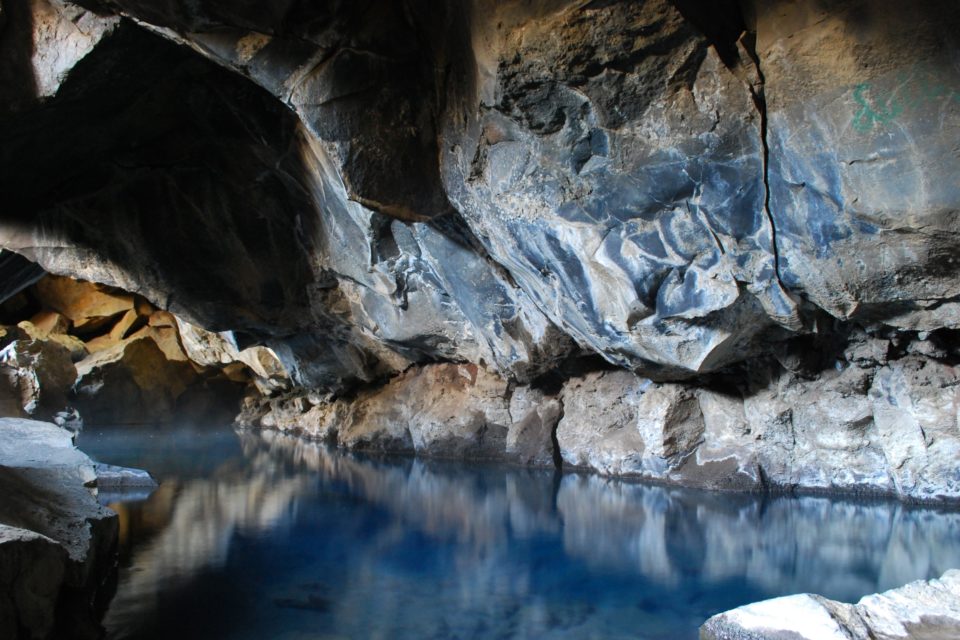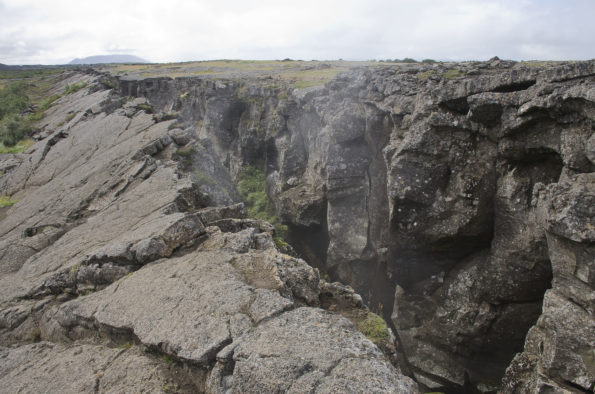
There are two caves in Mývatn area waiting to be discovered: Grjótagjá and Stóragjá.
Grjótagjá
The entrance to this cave is inside a gaping fissure. The water that fills the cave is brightly blue and utterly clear, the air inside is warmed up by the heat of the water and the whole setting is otherworldly. The bottom of the pool is as rocky as the ceiling and the surface of the water seems to be a mirror reflecting the same picture both upwards and downwards. Unfortunately it’s not possible to dive into the tempting naturally heated pool (danger of falling rocks from the ceiling). The outside top part of the fissure is less impressive than Stóragjá but the wild and barren landscape is wonderful.
History
Grjótagjá became the first time known among Icelanders in the 18th century when it was home to the outlaw Jón Markússon. Throughout the history people avoided lava caves because of their darkness and reputation for trolls, what turned them into the perfect home for bandits or outlaws. Today not much is known about Jón, but locals would continue to tell each other scary stories about him. Later the cave became a popular hot spring for bathing. Actually there are two caves right next to each other and one was used by women and other by men because people often chose to take a skinny dip. One can imagine the outcry when some teenage boys found a secret way – that is no longer open- to enter the ladies cave!

Between 1975 and 1984 the Krafla volcanic system erupted nine times, increasing the temperature of the water enormously. Nowadays the water is too hot and bathing in the cave has been forbidden a while ago. Even though the temperature of the water has slowly cooled down since 1984 it can rapidly increase again at any time because liquid rock is just two kilometers under the surface of the earth.
In 2018 the landowners were forced to close the southern cave because guests did not respect the nature, left litter and whatnot. Still it is possible to glimpse inside the cave through the iron bars. A good reminder on what effect disrespectful behavior can have. Both caves are on private land, even though they are open for the public.
Commonplace
In the last years Grjótagjá became known as the “Game of Thrones Cave”. The otherworldly beauty fascinated producers of the HBO’s series Game of Thrones so they decided to shoot one of the most iconic scenes there. In Season Three, Episode Four, Grjótagjá is used as the setting for the much anticipated love scene between Jon Snow and the wildling woman Ygritte, where Jon Snow ‘proves’ his abandonment of the Night’s Watch by consummating their relationship. If you are wondering where the waterfall is- it has been added with CGI.
Getting There
Take road nr. 1 and look out for the sign “Grjótagjá” between Reykjahlíð town and the entrance to Mývatn Nature Bath. Turn in there and follow the road for 2km until you reach the parking lot right in front of the cave.
GPS: 65°37’41.0″N 16°52’52.8″W
Stóragjá
A stone’s throw from Reykjahlíð, the main town of Mývatn in the north-eastern corner, an apparently regular moss field is cracked by an impressive fissure named Stóragjá. Climbing down to the bottom of it you would feel a weird anguish feeling increase within you. In some part the walls are so close to each other it almost looks like the earth is swallowing you while you walk. A poky hole is the entrance of a cave which was a popular spot to dive into the warm waters. Unfortunately now it is no longer safe to do that because of some dangerous algae.
Getting There
Stóragjá can be best reached by foot leaving the car at the gas station and local supermarket in Reykjahlíð and then walking past the Mývatnsstofa visitors centre and small wooden house selling handicraft. Carefully cross the road at the crossing between road nr. 1. and road nr. 848 At the other side of the street crossing are some wooden posts marking the way to the fissure.
GPS: 65°38’23.7″N 16°54’34.4″W